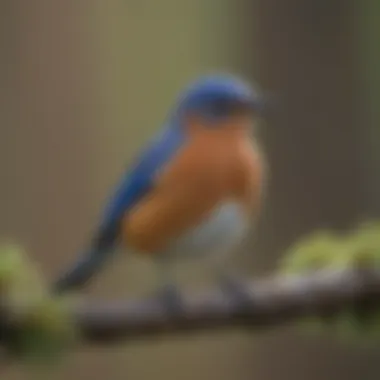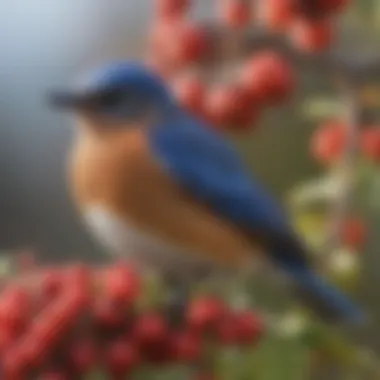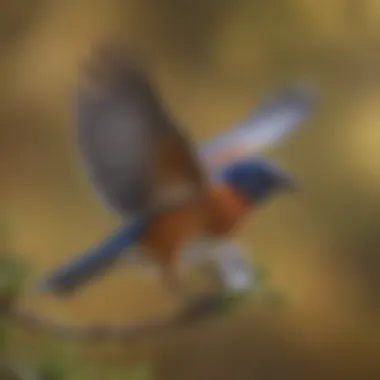Exploring the Diet of the Eastern Bluebird


Nature Topic Overview
The eastern bluebird is a small bird with vibrant colors and a beautiful song. Known scientifically as Sialia sialis, this bird thrives across North America and is especially recognized by its bright blue plumage and reddish-brown breast. The diet of the eastern bluebird is crucial for its survival and plays a role in the ecosystem where it lives.
Eastern bluebirds are omnivorous, meaning they eat both plants and animals. Their diet changes with the seasons. In spring and summer, they mainly consume insects and other invertebrates. In the colder months, fruits become a significant part of their diet. Understanding what these birds eat helps us appreciate their role in controlling insect populations and aiding in seed dispersal.
Key Points
- Food Sources: The eastern bluebird's diet includes insects, fruits, and berries.
- Seasonal Changes: Their feeding habits adapt according to the seasons.
- Nutritional Needs: They need a variety of foods to maintain health and energy.
- Ecological Role: They help control insects and spread seeds, benefiting their habitat.
Fun Facts and Trivia
- Did you know that eastern bluebirds can eat up to 100 insects in one day?
- They are often seen perching on fences or low branches, watching for food.
- These birds are social during the winter and can form flocks.
Visuals can be powerful. Consider using illustrations of eastern bluebirds amongst the fruits and insects they eat. Adding quick quizzes about their diet can also engage young readers, making learning fun.
Environmental Awareness
Understanding the diet of eastern bluebirds is not just about the bird itself. It opens up discussions about environmental health. Preservation of their habitats is crucial for their survival.
Why Conservation Matters
- Habitat Loss: Urban development and agriculture can destroy the places where bluebirds live.
- Sustainable Practices: Encouraging organic farming and planting native plants helps provide food for these birds.
Children can aid in conservation efforts by creating bird-friendly environments in their backyards. Planting berry-producing plants or leaving out water sources can provide support for local bird populations.
DIY Nature Activities
Engaging with nature can inspire a love for birds and environmental stewardship among kids. Here are some activities:
- Build a Bird Feeder:
Materials needed: a pine cone, peanut butter, and birdseed.
Steps: - Nature Sketching: Provide children with notebooks to draw different birds they see, including eastern bluebirds. Encourage them to document changes in their feeding behavior with the seasons.
- Cover the pine cone in peanut butter.
- Roll it in birdseed until well coated.
- Hang it outside on a tree branch.
These activities not only connect children with nature but also teach them about bird diets and habitats.
"Every bit we do to help wildlife contributes to the overall health of our planet."
Observing and maintaining the necessary conditions for eastern bluebirds can yield a richer and more diverse natural world.
Foreword to the Eastern Bluebird
The eastern bluebird is more than just a bird with beautiful colors; it plays a crucial role in our ecosystem. Understanding its diet is essential for several reasons. First, the diet of the eastern bluebird reflects the health of its habitat. Changes in food availability can indicate shifts in environmental conditions. This information can help conservationists in their efforts to protect these birds.
Second, studying what eastern bluebirds eat gives insight into their behaviors and life cycles. Every season brings different food options, which in turn affects their breeding and migration patterns. By knowing their dietary preferences, we can better understand how these birds adapt to changes in their environment.
In addition, this knowledge has practical implications. Farmers and gardeners can benefit from understanding the role of these birds in pest control. Eastern bluebirds consume a wide variety of insects, helping to keep pest populations in check. Encouraging their presence through habitat preservation can promote a healthier agricultural and garden environment.
Overall, the study of the eastern bluebird’s diet is essential for ecological awareness and conservation initiatives. The following sections will explore taxonomy, geographic distribution, as well as habitat preferences, feeding behavior, and diet composition, all of which build on our understanding of this fascinating bird species.
Taxonomy and Classification
The eastern bluebird, Sialia sialis, belongs to the family Turdidae, which also includes thrushes. This classification highlights their relationship with other bird species that share similar characteristics. The name "bluebird" stems from the males’ bright blue plumage, while females display more subdued colors. This dimorphism is common in many bird species, particularly those with distinct mating rituals.


This species is not just limited to the United States. Its taxonomy includes three recognized subspecies. Each has minor variations that allow them to adapt to their specific regions. Knowing their classification helps in understanding their evolutionary history and ecological niche.
Geographic Distribution
Eastern bluebirds are primarily found across North America. Their range extends from southern Canada down through the eastern United States to Mexico. These birds prefer open fields, orchards, and areas with scattered trees. They thrive in habitats where they can easily spot insects and fruits.
In recent years, the range of the eastern bluebird has expanded, even into urban areas. This ability to adapt to environments altered by human activities shows how resilient they can be. However, it also emphasizes the need for continual habitat preservation efforts. Understanding where these birds live reinforces our knowledge of their dietary habits and ecological interactions.
"The distribution of eastern bluebirds reflects the quality and availability of their food sources, which are crucial to their survival."
By studying the geographic aspects of eastern bluebirds, we uncover their connection to the landscape and the importance of conserving their natural habitats.
Habitat Preferences
Understanding the habitat preferences of the eastern bluebird is crucial for comprehending its diet and overall well-being. The habitats these birds favor dictate the availability of resources they need to thrive. The importance of this topic cannot be overstated, as habitat loss directly links to declines in bluebird populations. Their survival is closely tied to specific environmental features that support their dietary needs, nesting, and general life cycle.
Natural Habitats
Eastern bluebirds predominantly inhabit open woodlands, farmland, and meadows. These natural habitats provide the right mix of trees for perching and open grassy areas for foraging. Bluebirds utilize varied landscapes where they can spot insects and fruits from a distance. Key vegetation types include:
- Deciduous trees: Essential for perching and seeking shelter.
- Grassy fields: Vital for hunting insects like beetles and caterpillars.
- Fruit-bearing shrubs: Important for their berry consumption during specific seasons.
In a natural setting, the food chain is vibrant. Insects flourish in these habitats, acting as a primary food source for eastern bluebirds, especially during the breeding season. The availability of these resources impacts their reproductive success directly, making habitat quality a focal point for conservation efforts.
Urban and Rural Adaptations
Interestingly, eastern bluebirds have shown a remarkable ability to adapt to urban and rural environments. While they are traditionally associated with natural landscapes, they have begun to thrive in suburban areas. This shift is significant for a few reasons:
- Access to new food sources: Gardens and parks in urban areas often have a variety of insects and cultivated fruits, which bluebirds readily consume.
- Artificial nesting sites: Bluebird boxes are increasingly installed in parks and backyards, providing safe places for nesting.
These adaptations help the eastern bluebird maintain its population despite changing environmental conditions. However, adaptations require careful observation and support from communities to ensure sustainable practices that protect their evolving habitats.
Feeding Behavior
Understanding the feeding behavior of the eastern bluebird is essential for several reasons. This topic sheds light on how these birds interact with their environment and adapt to changes in their ecosystem. By examining their feeding techniques and social habits, we can appreciate their unique adaptations and contributions to biodiversity. Knowledge of feeding behavior helps in understanding the eastern bluebird's position in the food chain and its role in pest control and seed dispersal.
Foraging Techniques
Eastern bluebirds exhibit diverse foraging techniques that allow them to effectively hunt for food. Their primary food sources include insects, which are abundant in summer and spring. During these seasons, bluebirds can often be seen perched on fences or low branches, scanning the ground for movement. When they detect a potential meal, such as a grasshopper or beetle, they swiftly dive down to catch it.
In addition to ground foraging, eastern bluebirds are skilled at catching insects in flight. This strategy is particularly useful in open areas where they can see insects more easily. Bluebirds will often engage in aerial pursuits, darting through the air to catch unwary insects. This technique not only provides a meal but also showcases their agility and speed.
During fall and winter, as insect populations decrease, their foraging tends to shift towards fruits and berries. They may forage from shrubs and trees, using their beaks to pick berries, which provide necessary sugars and energy. This flexible foraging behavior highlights their adaptability to seasonal changes, ensuring their survival.
Social Feeding Habits
The eastern bluebird also displays interesting social feeding habits. They are generally solitary or found in small groups, especially during the breeding season. However, when food is plentiful, they may gather in larger groups. This social interaction during feeding can benefit the species by enhancing their foraging success. More eyes scanning the area can help them locate food sources faster.
Interestingly, young bluebirds learn foraging skills from their parents. This learning process includes how to identify food, preferred foraging locations, and techniques for capturing prey.
"Observing bluebirds' feeding behavior allows us to understand their ecological roles better and the importance of maintaining healthy habitats."
In addition to learning, social dynamics play a role in feeding. In areas where food is abundant, bluebirds may display competition among themselves, leading to more aggressive behaviors. This competition is natural; it ensures those who are most adept at foraging have a better chance of survival.
In summary, the eastern bluebird's feeding behavior is a multifaceted aspect of its ecology. Their techniques, adaptability, and social interactions surrounding food are critical for their well-being and the health of their habitats.


Diet Composition
Understanding the diet composition of the eastern bluebird is vital for comprehending its role within the ecosystem. This section sheds light on the various food sources that these birds consume and how their diet changes based on factors like seasons and availability. Such knowledge is crucial not only to appreciate their ecological niche but also to ensure their continued survival in changing environments.
Insectivorous Diet
Eastern bluebirds are primarily insectivorous, meaning they depend heavily on insects for their nutritional needs. They hunt insects like crickets, grasshoppers, beetles, and caterpillars, which provide essential proteins. This protein source supports their growth, reproductive health, and energy levels. During the breeding season, the need for protein increases as parents feed their young.
Their foraging techniques are quite adaptive. Bluebirds often perch on high points, scanning the ground below for movement. Once they spot a potential meal, they swoop down to catch it, showcasing their precision and agility. This feeding behavior plays a significant role in controlling insect populations, making eastern bluebirds important ecological participants.
Fruiting and Berry Consumption
In addition to insects, the eastern bluebird enjoys a variety of fruits and berries. This part of their diet becomes particularly significant during late summer and autumn when insects become less abundant. They actively seek out berries from plants like dogwood, blackberries, and elderberries. This fruit consumption not only satisfies their hunger but also provides vital vitamins and carbohydrates necessary for energy.
The digestibility of fruits is an important aspect of their diet, allowing them to store energy for winter months. Additionally, by consuming fruits, bluebirds play a role in seed dispersal. They help plants grow by spreading seeds through their droppings, facilitating new plant growth in other areas.
Seasonal Variations in Diet
The diet of eastern bluebirds is not static. It varies seasonally, adapting to the availability of food sources. In spring and summer months, they focus on insects, which are abundant during this period. As autumn approaches, their diet shifts towards fruits, which become more accessible.
During winter, when food is scarce, bluebirds still rely on smaller insects that may be hidden under snow or in warmer microhabitats. They may also seek out stored berries or dried fruits. Understanding these seasonal variations is crucial for conservation efforts, especially in habitats that may change due to climate factors or human activity.
"The adaptability of the eastern bluebird’s diet underscores its resilience in a changing environment."
Keeping track of diet composition helps in enhancing habitat conservation strategies. By ensuring that food sources remain available throughout all seasons, we can support the overall health and well-being of eastern bluebird populations.
Nutritional Needs
Understanding the nutritional needs of the eastern bluebird is crucial for appreciating its overall health and vitality. These birds require a balanced intake of nutrients to support their life processes, including reproduction, growth, and daily energy needs. The right mix of food influences their breeding success and survival rates. For instance, during breeding seasons, they need more protein to feed their young. Likewise, energy sources are vital during migration periods when they expend substantial energy.
Essential Nutrients
Eastern bluebirds primarily derive their nutrients from a mixed diet that varies throughout the year. The main categories of essential nutrients include:
- Proteins: This nutrient is crucial for growth and repair. Insects are a rich protein source. Bluebirds gather and consume various insects such as grasshoppers, beetles, and caterpillars during the warmer months.
- Vitamins: Key vitamins, such as A, C, and E, are important for immune function and overall health. Fruits and berries, eaten especially in late summer and early fall, provide these necessary vitamins.
- Minerals: Calcium and phosphorus are essential for bone health and reproductive success. This can come from insects and a variety of fruits as well.
- Fats: Unsaturated fats, found in some fruits and seeds, are needed for energy and to maintain body temperature during colder months.
By ensuring their diet includes these nutrients, eastern bluebirds maintain a strong immune system and reproductive capabilities.
Impact of Diet on Health
The diet of the eastern bluebird has a profound impact on its health. A well-nourished bluebird tends to showcase vibrant plumage, which is essential for attracting mates. On the flpside, diet deficiencies can lead to health issues, such as weak bones or poor feather quality. Furthermore, access to healthy food sources directly correlates with the bird's ability to successfully raise its young.
Moreover, changes in the environment can influence food availability, impacting the bird's health. For example, areas with limited insect populations due to pesticide use or habitat destruction may lead to malnutrition for these birds. Some key considerations regarding diet and health are:
- Maintaining Biodiversity: A diverse diet enables better health. Bluebirds, by consuming a variety of food sources, lower their risk of nutritional deficiencies.
- Seasonal Feeding: They adapt their diet depending on the season. In late spring and summer, they prefer insects; however, as winter approaches, they shift to fruits and berries when insects are scarce.
- Impact of Climate Change: Changes in climate can alter the availability of key dietary components. This could lead to challenges in finding adequate food, affecting their overall survival.
Understanding these nutritional needs helps conservationists and nature enthusiasts support the health and well-being of eastern bluebird populations.
Predators and Threats
Understanding the section on predators and threats is crucial for appreciating the challenges faced by the eastern bluebird. This exploration sheds light on the various natural and human impact factors that influence their diet and overall survival. By recognizing these threats, readers can better understand the needs for conservation and habitat protection. It also highlights the delicate balance within ecosystems, where every species, including the bluebird, plays a vital role.
Natural Predators
The eastern bluebird faces predation from several natural predators. Some of the most notable include:


- Hawks: Various hawk species are known to prey on small birds like bluebirds. Their keen eyesight and swift flight allow them to capture bluebirds in open areas.
- Snakes: Ground-dwelling snakes can be a threat, especially when bluebirds are nesting. They may raid nests to eat eggs or hatchlings.
- Felines: Domestic cats pose a significant risk to bluebirds. They hunt birds in gardens and yards, leading to declines in local populations.
- Birds of Prey: Larger birds, such as crows and jays, may attack bluebirds when they are vulnerable or in large numbers, competing for food or nesting sites.
Understanding these predators helps highlight the risks bluebirds face in their natural habitats. It is essential to consider these threats when implementing conservation strategies and promoting biodiversity.
Human Impacts on Food Sources
Human activities have considerable effects on the food sources available to eastern bluebirds. These impacts range from habitat destruction to pollution and agricultural practices. Key factors include:
- Habitat loss: As urban areas expand, bluebirds lose nesting and foraging habitats. This reduces the availability of insects and fruits that are crucial for their diet.
- Pesticides: The use of pesticides in agricultural settings can lead to a decrease in insect populations. Since bluebirds rely heavily on insects, this can affect their health and survival.
- Pollution: Water and air pollution can reduce the quality of the habitats bluebirds depend on. Polluted areas may not support the diverse insect life that bluebirds require.
- Climate Change: Changes in climate can alter the timing and availability of food sources. Bluebirds may struggle to find adequate nourishment during critical migration and breeding periods.
By understanding human impacts on food sources, we can work towards creating a balanced environment where eastern bluebirds can thrive. Conservation efforts often require collaboration between communities, policymakers, and environmental organizations to restore habitats and protect food sources.
Conservation Status
Conservation status of the eastern bluebird is crucial for understanding its future. These birds face various challenges that affect their survival. Addressing these issues helps in keeping their populations healthy and stable. Protecting their habitats is a major factor. The loss of natural environments leads to a decline in their food sources and nesting sites.
Population Trends
The population trends of the eastern bluebird show both ups and downs. In the past, they were abundant in many areas of North America, but changes in agriculture and urban development have affected their numbers. According to the North American Breeding Bird Survey, the population has seen a general increase since the 1980s. This is due to increased awareness and conservation efforts.
Monitoring these trends helps understand how external factors influence their populations. For example:
- Habitat loss due to urbanization impacts bluebirds directly.
- Climate change affects food availability, especially during harsh winters.
- Competition with other species, such as house sparrows, also plays a role.
Conservation Efforts
Conservation efforts for the eastern bluebird have included various actions. Organizations and researchers work together to protect these birds. Some effective strategies include:
- Nest box programs: These provide safe nesting sites for bluebirds in areas where natural cavities are scarce.
- Habitat restoration projects: By restoring and preserving grasslands, bluebirds gain access to food and shelter.
- Educational initiatives: Raising awareness in communities encourages support for bluebird conservation.
These efforts are essential to maintain a balanced ecosystem. When bluebirds thrive, they contribute to pest control and plant pollination. Hence, their conservation is not just about saving a bird; it's about supporting the entire environment.
"Each step taken in the conservation process leads us closer to a world where eastern bluebirds can soar freely".
Closure
Understanding the diet of the eastern bluebird is vital for several reasons. Firstly, it sheds light on the bird’s role in the ecosystem. By eating large numbers of insects, eastern bluebirds help regulate pest populations. This natural pest control is beneficial for farmers and gardeners alike.
Secondly, knowledge of their diet informs conservation efforts. As the eastern bluebird relies on specific food sources, changes in habitat and food availability can have significant impacts on their populations. Maintaining healthy environments ensures these birds have access to the insects and fruits they need.
Conservation of the eastern bluebird is closely linked to the preservation of its food sources. Without them, the bird's survival becomes increasingly challenging.
Thirdly, understanding their dietary needs allows for better research into their behaviors and health. When researchers know what eastern bluebirds eat, they can make more informed conclusions about what affects their well-being.
In summary, learning about the eastern bluebird's diet reveals not only the bird’s habits but also highlights the interconnectedness of species within ecosystems. Conservation and unity between human activities and wildlife needs are key considerations moving forward.
The Importance of Understanding Diet
The diet of the eastern bluebird plays a central role in its life cycle. By knowing what these birds eat, researchers can track healthy populations and ensure their habitats support their needs.
Eastern bluebirds primarily eat insects during the breeding season. This food is essential for their growth and nesting success. In contrast, they consume fruits and berries in the winter. This adaptability shows how climate and seasonal changes influence their diet.
Moreover, comprehending the dietary habits aids in educational efforts. Teachers and parents can use this knowledge to instill appreciation for nature in children. Activities can involve observing bluebirds in their local area. Such engagements foster a sense of responsibility towards conservation and environmental stewardship.
Future Directions in Research
Future research on the eastern bluebird’s diet should focus on a few key areas. One important direction is the impact of climate change on food availability. As weather patterns change, so too might the distribution of insects and fruits. Studying these shifts can provide insight into how this species will adapt or struggle.
Another area for exploration is the role of invasive species. Invasive plants may alter the availability of native fruits that eastern bluebirds rely on. Understanding this relationship can inform conservation strategies to restore natural balance in ecosystems.
Finally, citizen science projects that involve monitoring eastern bluebird populations can be beneficial. Data collected from enthusiasts can help researchers assess trends in diet and survival rates across different regions.







